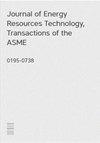ch4对c2h4扩散火焰中烟灰形成的影响
IF 2.4
3区 工程技术
Q3 ENERGY & FUELS
Journal of Energy Resources Technology-transactions of The Asme
Pub Date : 2023-08-25
DOI:10.1115/1.4063254
引用次数: 0
摘要
研究多种燃料的共燃对烟灰形成的影响已成为烟灰颗粒研究的热点。本文通过实验和数值模拟研究了甲烷掺混对乙烯火焰燃烧烟尘形成的影响。实验中采用可见光谱火焰图像处理技术对层流火焰温度和碳烟体积点进行了原位测量。基于多环芳烃(PAHs)的分段颗粒动力学煤烟模型,利用CoFlame Code分析了不同甲烷配比对煤烟颗粒成核、聚结、表面生长和氧化过程的影响。结果表明,在低甲烷混合比下,协同效应促进了氢提取的成核和加成反应速率的提高,烟灰总质量的增加主要是由于PAH的缩合速率。随着混合比的增加,烟灰的产生总量逐渐减少。火焰中的冷凝、表面生长速率和烟灰成核的总体趋势随着混合比的增加而减小。在火焰燃烧反应的初始阶段,成核速率从单峰逐渐转变为双峰,并略有增加。值得一提的是,三种PAH前体(BAPYRS、BAPYR和BGHIF)和温度的变化解释了成核速率从单峰到双峰的变化。本文章由计算机程序翻译,如有差异,请以英文原文为准。
EFFECT OF CH4 ADDITION ON SOOT FORMATION IN C2H4 DIFFUSION FLAME
Studying the effect of co-combustion of multiple fuels on the soot formation has become a hot spot in the investigation of soot particles. In this paper, the influence of methane blending on soot formation in ethylene flame combustion is studied experimentally and numerically. The visible spectrum of flame image processing technology was used to in situ measurement of laminar flame temperature and carbon smoke volume points in the experiment. The effects of different methane blending ratios on particle nucleation, coalescence, surface growth and oxidation process of soot were analyzed based on the piecewise particle dynamics soot model of polycyclic aromatic hydrocarbons (PAHs) by using CoFlame Code. Results indicate that the synergistic effect promoted the increasing rate of nucleation and addition reaction of hydrogen extraction at low methane blending ratio, and the increase of the total mass of soot was mainly due to PAH condensation rate. The total amount of soot generation gradually decreases with increasing blending ratio. The overall trend of condensation, surface growth rate and soot nucleation in the flame decreases with increasing blending ratio. And the nucleation rate gradually shifts from a single peak to a double peak and increases slightly at the initial stage of the flame combustion reaction. It is worth mentioning that the change of three PAH precursor (BAPYRS, BAPYR and BGHIF) and the temperature explains the change of nucleation rate from unimodal to bimodal.
求助全文
通过发布文献求助,成功后即可免费获取论文全文。
去求助
来源期刊
CiteScore
6.40
自引率
30.00%
发文量
213
审稿时长
4.5 months
期刊介绍:
Specific areas of importance including, but not limited to: Fundamentals of thermodynamics such as energy, entropy and exergy, laws of thermodynamics; Thermoeconomics; Alternative and renewable energy sources; Internal combustion engines; (Geo) thermal energy storage and conversion systems; Fundamental combustion of fuels; Energy resource recovery from biomass and solid wastes; Carbon capture; Land and offshore wells drilling; Production and reservoir engineering;, Economics of energy resource exploitation

 求助内容:
求助内容: 应助结果提醒方式:
应助结果提醒方式:


